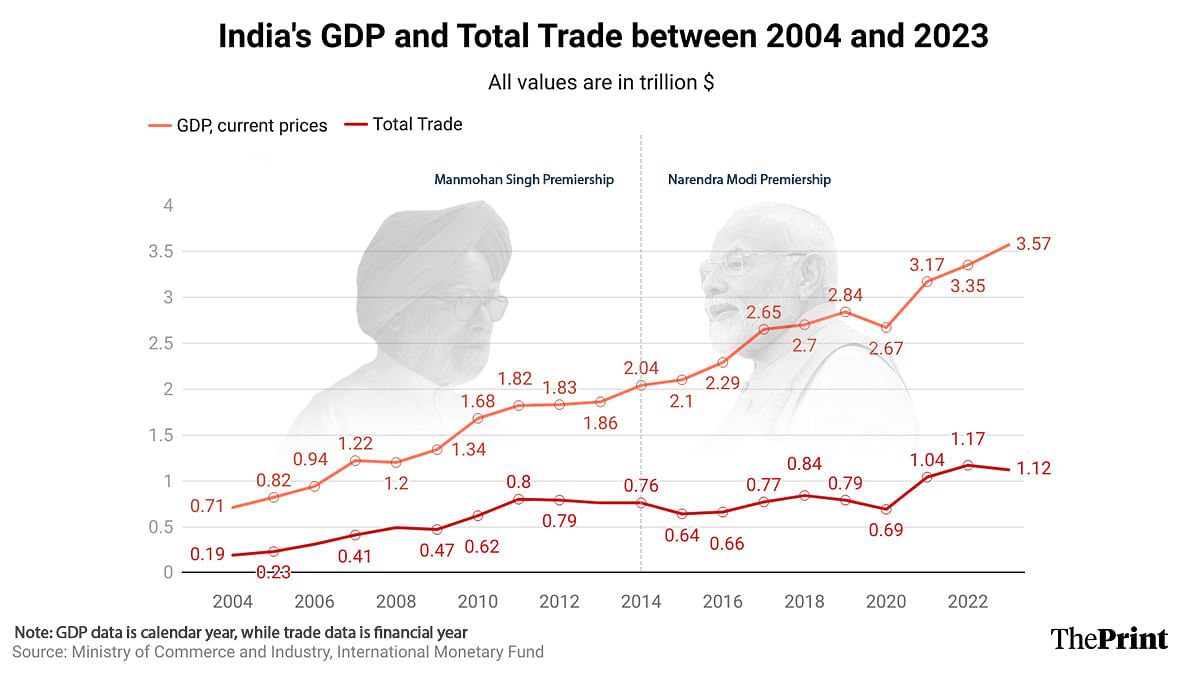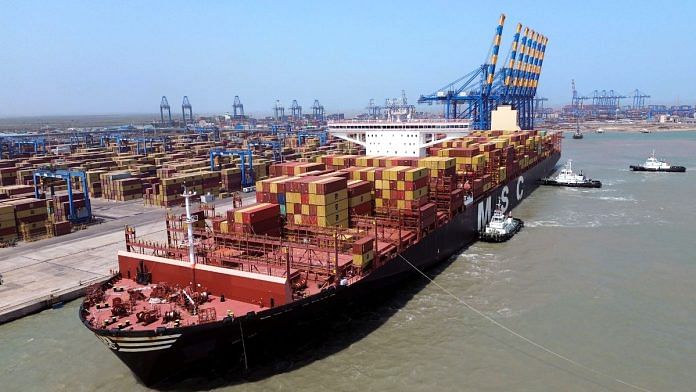New Delhi: At a time when India has restarted talks on several stalled trade deals, export, import and Gross Domestic Product (GDP) data shows how trade has played a shrinking role in India’s growth story over the last decade.
In February, India restarted a number of stalled trade agreements with the European Union (EU) and the United Kingdom. It also announced the start of negotiations for a trade deal with the US.
An analysis by ThePrint shows that exports, in particular, despite having seen some years of positive growth, have remained stagnant as a percentage of India’s GDP, even seeing a decline for several years over the past decade.
India has been keen to promote its attractiveness as a manufacturing destination, as the Western world has increasingly looked to diversify its supply chains from China following the COVID-19 pandemic. The EU, for example, has labelled Beijing as a “systemic rival”. Furthermore, the US under President Donald Trump has upended the international trading system with the use of blunt tools such as tariffs in order to reduce America’s trading deficits.
The latest round of 25 percent tariffs on Canadian and Mexican imports imposed by the new US administration took effect late Monday night, while China announced retaliatory tariffs of 10 to 15 per cent on Washington’s agricultural products. The use of tariffs further hits the competitiveness of exports.
Also Read: India-UK relaunch negotiations for free trade agreement. What threatens it
India’s trade over the last 2 decades
In 2004, when the Congress-led United Progressive Alliance (UPA) came to power, India’s GDP stood at $709 billion, according to the International Monetary Fund (IMF). That year, India’s total trade—imports and exports—stood at $190 billion, about 26.9 percent of the GDP.

During the decade of UPA rule, India’s total trade as a percentage of GDP touched a peak of 43.6 in 2011, before falling to around 37.2 per cent by 2014, when Prime Minister Narendra Modi and the National Democratic Alliance (NDA) stormed to power. However, despite the Modi government’s push for increasing exports, the overall role of trade in the last decade has shown a different trajectory.
In 2023, the total share of trade as a percentage of India’s GDP stood at 31.3 percent, which is much lower than during at least eight of the 10 years under the UPA.

The Union Budget 2025-26, announced by Finance Minister Nirmala Sitharaman on 1 February, declared exports as “the fourth engine” of growth for India. For most of the early years of the Modi government before the COVID-19 pandemic, the value of India’s exports remained similar to that of the last years of Manmohan Singh’s premiership. It is only after the COVID-19 pandemic that exports crossed the $400 billion mark and remained so for the last three years.
However, as a percentage of the GDP, exports peaked at 16.8 per cent in 2011 under the previous UPA regime, and has since fallen to 12.3 per cent in 2023. It should be noted that, since the pandemic, India’s total trade in goods has crossed $1 trillion, which for the most part has been led by the increase in imports of goods.
Imports of goods in India
From $107.1 billion in 2004, India’s imports of goods have grown to $678.1 billion in the 2023-24 financial year. In terms of percentage of India’s total GDP, imports have also grown from around 15 percent in 2004 to 19 percent in 2023.

Under both the UPA and NDA governments, imports of goods have increased substantially as a percentage of GDP. In 2012, India’s imports, which stood at $490.7 billion, peaked at 26.85 percent of the total GDP of the country when Manmohan Singh was prime minister.
Under PM Modi, imports as a share of GDP fell below $400 billion in the first couple of years before crossing $465 billion in 2017 and then touching $514 billion in 2018. That year, as a share of India’s GDP, imports accounted for 19 percent. However, after the COVID-19 pandemic, India’s imports have seen rapid growth, touching $715 billion in 2022 before falling to $678 billion the following year.
In 2022, India’s imports accounted for roughly 21.35 percent of its total GDP. This was only the second time during Modi’s tenure where imports accounted for over a fifth of India’s GDP.
(Edited by Sanya Mathur)
Also Read: India’s heightened economic policy uncertainty is hurting investor sentiment, IMF says







Modi and his team have not handled the economy properly. Chest thumping about being the 5th largest economy in the world does little to hide their failures.
And Indian industry is the primary culprit for this scenario. Despite record low corporate tax and repeated urgings fron the Union government, they have not invested in the Indian economy. Rather, they invested overseas and created jobs and infrastructure in other nations. So tax cuts in India ultimately benefited foreign nations.
It’s quite obvious now that nationalism drives only the middle class – the usual idiots. Industry is not swayed by nationalism. Neither do tax cuts entice them to invest in the domestic market.
Carrots, quite clearly, have not worked till now. I genuinely wish the Modi government uses the stick now.
If I become the PM, I will sign free-trade agreements with all the countries in the world in one day, increase supply of goods, deflate the prices, make consumer the king.